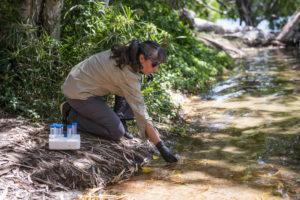Environmental DNA (eDNA) is the trace genetic material that all animals and plants leave behind in their environment in the form of skin cells, mucous, faeces, etc. For aquatic species, eDNA can be extracted from water samples and screened for the presence of the target species using specific DNA markers. The main advantages of the method are that detection is not dependent on seeing or hearing the animals – greatly reducing sampling costs – and it is able to detect low numbers of individuals (e.g. rare species or early incursions of invasive species). This means that monitoring programs can be conducted rapidly, at lower cost and across a large range of locations, and field sampling can be undertaken by non-specialists including Indigenous rangers and citizen scientists. The goal of this research was to develop and utilise eDNA techniques to improve monitoring of key species in northern Australia.
Fieldwork is expensive and laborious, especially in remote northern Australia. Traditional sampling equipment may be expensive and require expert training to operate or be difficult or impossible to deploy. Our eDNA methods overcome these challenges as they do not require specialised training or equipment and can be conducted rapidly. As a result, sampling can be more frequent and widespread, providing much more data on the occurrence of aquatic plants and animals and leading to more effective management of key threatened or invasive species.

This research has refined eDNA methods so that collecting a water sample can be as simple as filling a tube with water rather than filtering water on-site or needing refrigeration. Photo: Northern Australia Environmental Resources Hub.
The Northern Australia Environmental Resources Hub addressed key research questions to come up with practical, on-ground solutions to some of the north’s most complex environmental challenges. A transdisciplinary research approach has been at the heart of the hub. Integrating key research users – policy-makers and land managers including Traditional Owners and ranger groups – into the co-design of research projects has led to rapid uptake of research outcomes into land management practices and decision-making. The hub has produced this wrap-up video outlining these impacts from the perspectives of research users.
The project was led by Professor Damien Burrows from James Cook University (JCU). He was assisted by other researchers at JCU, The University of Western Australia, Charles Darwin University, Griffith University and CSIRO.
Contact
Damien Burrows, James Cook University
damien.burrows@jcu.edu.au
(07) 4781 4262